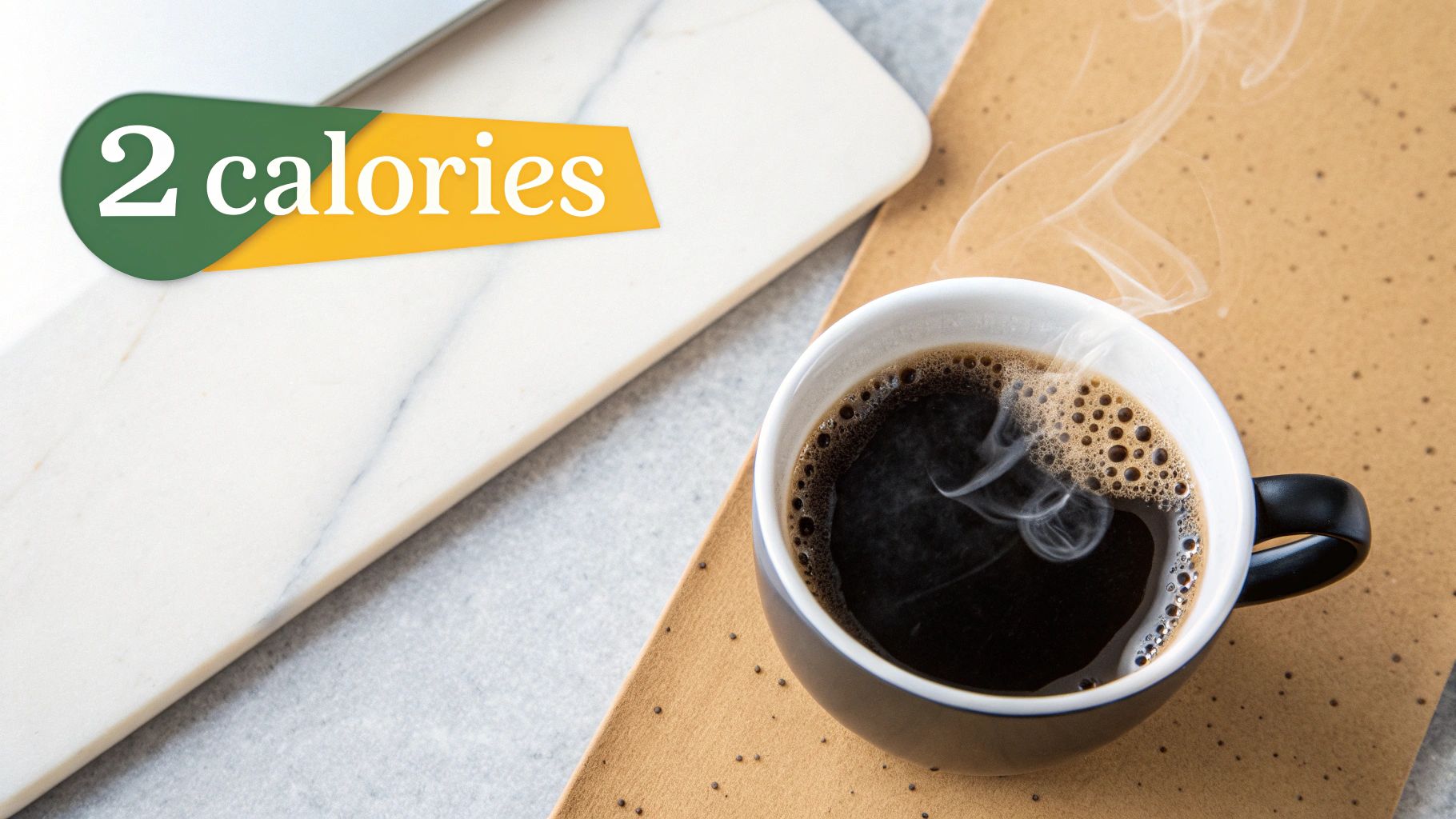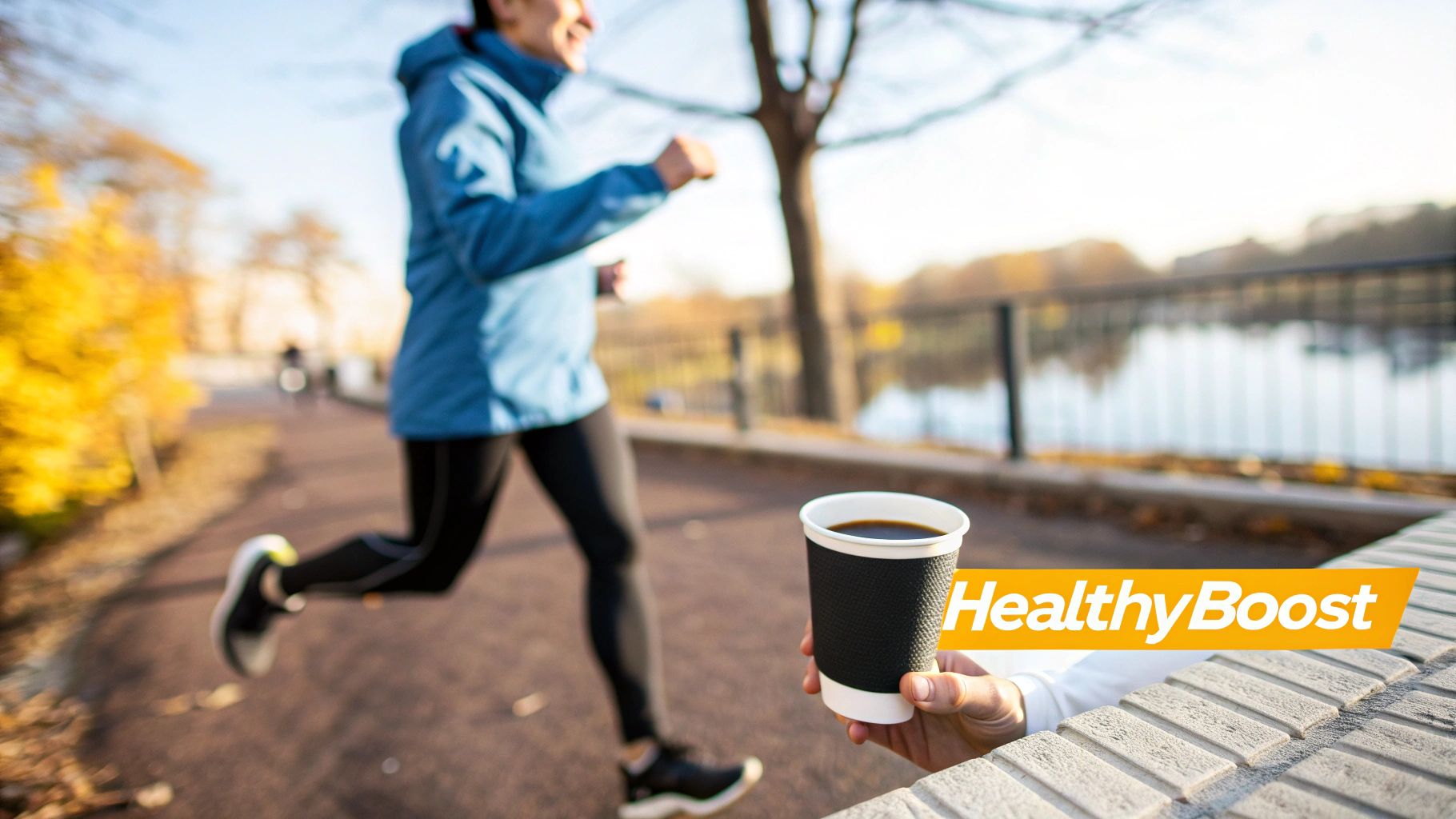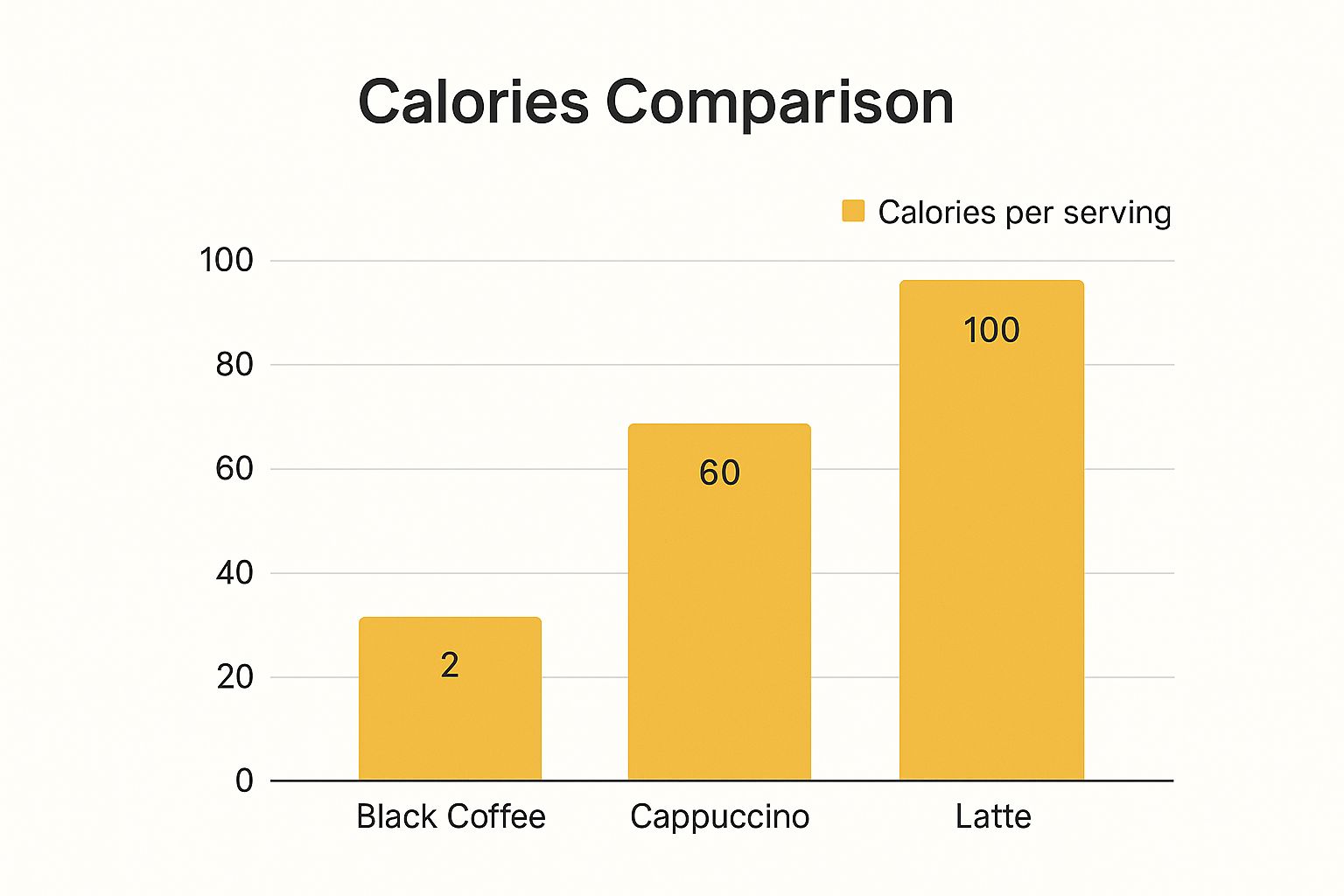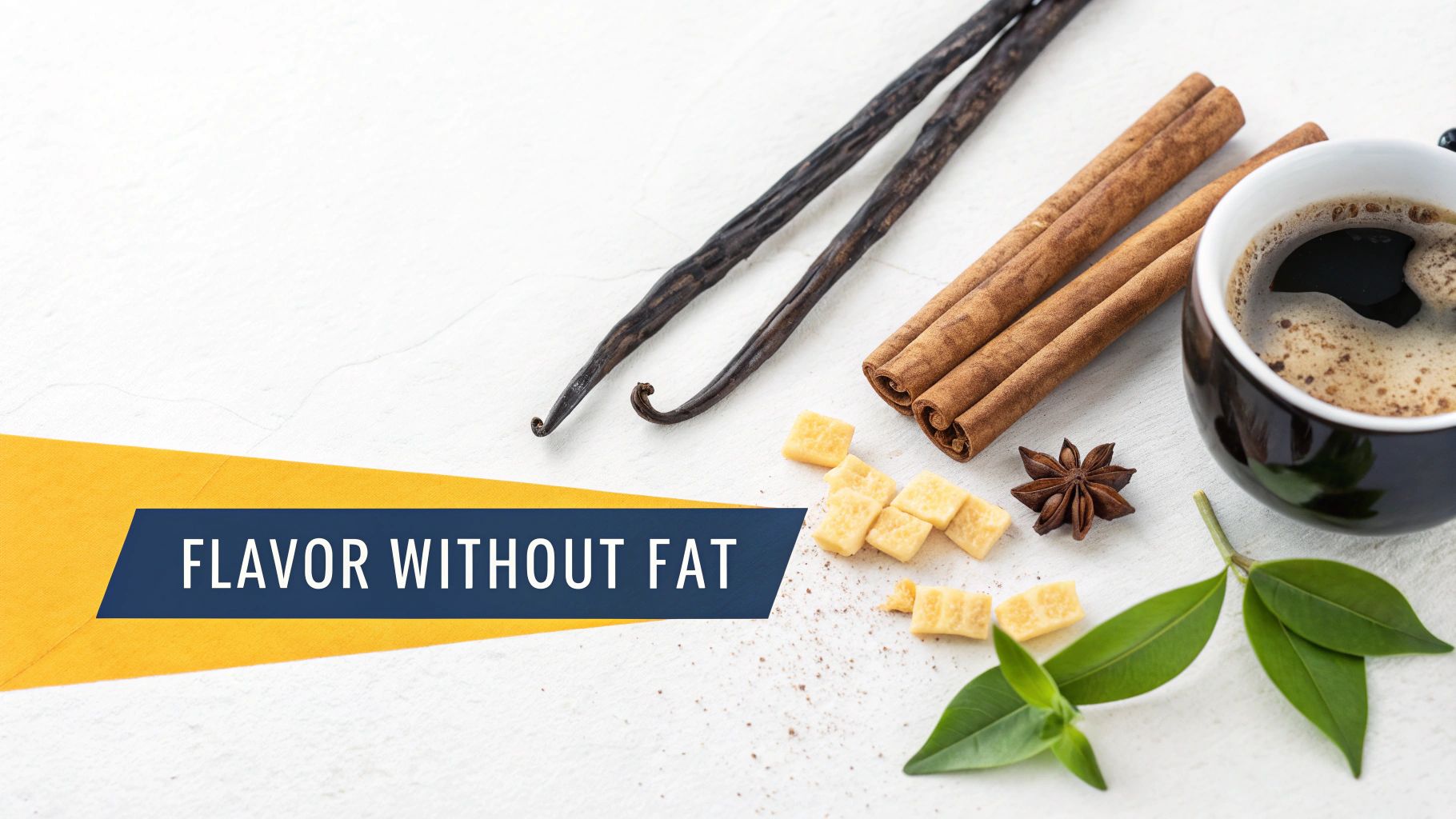When you look at the numbers, the calorie count for black coffee is astonishingly low. A standard 8-ounce cup has almost nothing in it—we're talking just 2 to 5 calories. This makes it the perfect go-to for anyone keeping an eye on their calorie intake.
How Many Calories Are in Black Coffee
If you're looking for a straight answer, here it is: black coffee is about as close to a zero-calorie drink as you can get.
So, where do those couple of calories even come from? They're from tiny, trace amounts of natural oils and proteins that get extracted from the coffee beans when you brew them. There are no sugars or fats to speak of.
This is exactly why it's a cornerstone for so many health and wellness routines. An 8-ounce (about 240 mL) cup of brewed black coffee clocks in at approximately 2 calories, with 0 grams of fat, 0 grams of carbs, and about 0.3 grams of protein. It’s just a simple, clean infusion of coffee and water.
A Simple Calorie Comparison
Think of black coffee's near-zero calorie count as a clean slate. The second you add anything to it, the numbers start to creep up. Even small additions can make a huge difference, turning your simple brew into something much more calorie-dense. Knowing how to prepare different coffee types, like instant, can also help you stay on top of your daily intake.
Let's put this into perspective to see just how quickly things can change.
The core idea is simple: the coffee itself isn't the problem. It’s the extras—sugar, milk, cream, and syrups—that can transform a 2-calorie drink into a high-calorie treat.
Calorie Quick View Black Coffee vs Common Add-Ins
See how quickly calories add up with common additions compared to a standard 8 oz cup of black coffee.
| Coffee Type | Estimated Calories |
|---|---|
| Black Coffee (8 oz) | 2-5 calories |
| Coffee with 1 tsp Sugar | 18-21 calories |
| Coffee with 1 tbsp Half-and-Half | 22-25 calories |
| Coffee with Milk & Sugar | 35-50 calories |
As you can see, that beautifully simple, nearly calorie-free cup of coffee doesn't stay that way for long once you start mixing things in.
The Nutritional Profile of a Standard Cup

When you hear that black coffee has almost no calories, it's easy to assume it’s just hot, flavored water. An "empty" drink, right? But that couldn't be further from the truth. Black coffee is actually a complex brew packed with beneficial compounds, all for a minimal caloric price tag.
Looking at the big three macronutrients—protein, fat, and carbs—their presence is so small it’s practically a rounding error. A typical 8-ounce cup has about 0.3 grams of protein and basically zero fat or carbs. This is the secret behind why the black coffee calories count stays so low.
But the real nutritional story isn't about what's missing; it's about all the good stuff hidden inside.
More Than Just Caffeine
While caffeine gets all the glory, your daily cup is quietly delivering a surprising number of micronutrients and powerful plant compounds. Every sip gives you small but meaningful amounts of essential minerals that help your body run smoothly.
You'll find a few key players in your mug:
- Potassium: Vital for balancing fluids, sending nerve signals, and helping muscles contract. Your cup of coffee contributes a small but helpful amount to your daily needs.
- Magnesium: This one is a workhorse, important for creating energy, keeping bones healthy, and regulating blood sugar. It's another little bonus in your brew.
- Niacin (Vitamin B3): Coffee is a decent source of niacin, which your body uses to convert the food you eat into usable energy.
These minerals subtly contribute to your overall health, turning your simple morning pick-me-up into a beverage with real nutritional value.
A cup of black coffee is like a treasure chest with a very light key. It costs almost nothing in calories to unlock a wealth of antioxidants and micronutrients that support your well-being.
A Rich Source of Antioxidants
Maybe the most impressive part of coffee’s resume is its antioxidant profile. Antioxidants are your body's personal security team, protecting your cells from damage caused by unstable molecules called free radicals. Coffee is loaded with a specific type called chlorogenic acids.
These powerful compounds are known for their anti-inflammatory effects and may even help lower the risk of some chronic diseases. So that morning ritual does more than just pry your eyes open—it actively helps defend your body at a cellular level.
This near-zero calorie status isn't just a local phenomenon; it's recognized globally. Nutritional databases around the world confirm that black coffee is virtually calorie-free. In Australia, for instance, a 200 mL long black has just 2 calories with negligible fat or sugar. This lines up perfectly with data from the US, Europe, and India, proving that black coffee is universally a low-calorie choice. If you want to dive deeper, you can learn more about coffee's minimal calorie content and see how different preparations stack up.
How Brew Method and Serving Size Affect Calories

While we know black coffee is consistently low-calorie, the exact number isn't always identical. Think of it like water from different natural springs—it's all water, but each has a slightly different mineral profile. In the same way, small variables in how you brew and serve your coffee can nudge the final calorie count.
The most obvious factor is serving size. This is just simple math: a 16-ounce grande cup will have roughly double the calories of a standard 8-ounce cup. Even though we’re only talking about a jump from maybe 2 calories to 4, it’s a direct relationship. The more coffee you pour, the more of those trace oils and compounds you get.
But beyond just pouring a bigger cup, the method you use to brew your coffee introduces some more interesting, subtle shifts.
Brewing Methods and Calorie Content
The way you pull flavor from coffee grounds also dictates how many oils and soluble solids land in your mug. It’s these microscopic bits that carry those few calories, and different brewing styles yield slightly different results.
Let's break down a few common methods:
- Drip Coffee: This is the go-to for a reason. Hot water flows through a paper filter, which does an incredible job of trapping most of the coffee's natural oils. The result is a crisp, clean-tasting cup with a rock-bottom calorie count, usually around 2 calories per 8 ounces.
- French Press: With this immersion method, you steep grounds directly in water and then press a metal filter down. Since there’s no paper to absorb them, more of the coffee's oils make it into your mug. This can bump the calorie count slightly to around 3-5 calories.
- Espresso: A shot of espresso is incredibly concentrated, but the serving size is tiny—just one ounce. A single shot typically has only 1-3 calories. An Americano, which is just espresso diluted with hot water, ends up in the same low-calorie ballpark as drip coffee.
The differences are tiny, but they show how extraction plays a role in what ends up in your cup.
Your choice of brew method is less about calorie management and more about flavor preference. Whether you choose a French press or drip coffee, the impact on your daily calorie intake is negligible.
Why Concentration Matters for Calories
Another key piece of the puzzle is your coffee-to-water ratio. This determines how concentrated, or "strong," your brew is. The stronger the coffee, the more dissolved solids and oils are floating around in every ounce.
Cold brew is a perfect example. Its concentrate is brewed with a much higher ratio of coffee to water over a long time. On its own, this concentrate is denser in calories than drip coffee. A 3-ounce serving of concentrate might have around 5-10 calories.
Of course, almost no one drinks the concentrate straight. You dilute it with water or milk, which brings the final calorie count of your finished drink right back down to the same level as a typical cup of hot coffee. Learning the best way to prepare coffee at home can help you dial in these ratios perfectly.
Ultimately, while serving size and brew method technically alter the calorie count, the changes are minimal. The core takeaway remains the same: no matter how you brew it, a cup of black coffee is an exceptionally low-calorie choice.
Why Coffee Add-Ins Are the Real Calorie Culprits
A plain cup of black coffee is a beautifully simple thing—and a nearly calorie-free one at that. But walk into any modern coffee shop, and that simple cup is often just the starting point. It’s the extras—the milks, sugars, syrups, and creams—that are responsible for turning a 5-calorie drink into something that looks more like a 400-calorie dessert.
Think of your black coffee as a blank canvas. On its own, it’s minimalist and clean. Every pump of syrup, splash of cream, or spoonful of sugar is another layer of paint, adding flavor, texture, and, of course, calories. Just one teaspoon of sugar adds about 16 calories, instantly quadrupling your drink's caloric load.
The Calorie Creep from Milks and Creams
Milk is easily the most common addition to coffee, but not all milks are created equal. The type you choose has a huge impact on the final calorie count. The simple rule? The higher the fat content, the more calories you're pouring into your cup.
Let's see how different options stack up when you add just a quarter cup (2 ounces) to your coffee:
- Skim Milk: Adds around 20-25 calories.
- Whole Milk: Adds approximately 35-40 calories.
- Half-and-Half: Jumps up to about 75-80 calories.
- Heavy Cream: Can add a staggering 200+ calories.
Even plant-based milks vary quite a bit. Unsweetened almond milk is a great low-calorie choice, often adding just 10 calories, while oat milk, loved for its creamy texture, can contribute 30-40 calories for the same amount.
The transformation from a simple coffee to a calorie-dense beverage doesn't happen by accident. It's a result of deliberate additions, each one contributing to a much larger total than most people realize.
To help you see how these little extras add up, here’s a quick breakdown of some popular choices.
Calorie Impact of Common Coffee Additives
This table breaks down the calories added by popular coffee additions, helping you visualize how your drink is customized.
| Additive | Serving Size | Typical Calories Added |
|---|---|---|
| Granulated Sugar | 1 teaspoon | 16 |
| Flavored Syrup (e.g., vanilla) | 1 pump (1 oz) | 20 |
| Honey | 1 teaspoon | 21 |
| Unsweetened Almond Milk | 1/4 cup | 10 |
| Oat Milk | 1/4 cup | 35 |
| Whole Milk | 1/4 cup | 40 |
| Half-and-Half | 2 tablespoons | 40 |
| Heavy Cream | 2 tablespoons | 100 |
| Whipped Cream Topping | Standard Dollop | 100+ |
As you can see, what starts as a small splash or a single pump can quickly become a significant source of calories, fundamentally changing the nutritional profile of your morning coffee.
From Americano to Dessert in a Cup
Let’s watch this happen in real time. We'll start with a simple black Americano, which comes in at a mere 5 calories. Now, let's build it into a popular café-style drink:
- Start with the Americano (5 calories).
- Add steamed whole milk to make it a latte (+80 calories).
- Mix in two pumps of caramel syrup (+40 calories).
- Top it off with whipped cream and a caramel drizzle (+150 calories).
And just like that, your 5-calorie drink is now a 275-calorie caramel macchiato. This kind of calorie stacking is incredibly common in commercial coffee chains. Historically, coffee was a simple, low-calorie staple. It was the rise of modern coffee culture that made high-calorie sweeteners and creams the norm, transforming the beverage entirely. A standard black coffee has just 2 calories per 100 mL, but adding milk can easily push that to 30-50 calories for the same volume. You can always discover more insights about coffee nutrition on Calories.info if you want to dig deeper.
This chart really puts it into perspective, showing just how fast the calories escalate when you move from a basic black coffee to milky café favorites.

The visualization makes it crystal clear: a latte can contain 50 times the calories of a black coffee. It’s a powerful reminder that the milk and foam—not the coffee itself—are the main caloric drivers.
Health Benefits of Low-Calorie Black Coffee

Choosing black coffee is about so much more than just picking a low-calorie drink; it's a move that actively supports your overall wellness. That near-zero black coffee calories count is really just the beginning of the story. This simple, unadorned beverage is absolutely packed with compounds that offer a surprising range of health perks.
Think about it: when you consistently swap a 300-calorie latte for a 5-calorie cup of black coffee, the difference adds up quickly. This simple change makes black coffee an incredible tool for anyone keeping an eye on their weight. It fits right into almost any dietary approach, from basic calorie counting to more structured plans like intermittent fasting, where it won't break your fast.
A Natural Metabolic Boost
Beyond being incredibly low in calories, the caffeine in black coffee gives your metabolism a natural nudge. While it's certainly not a magic pill for weight loss, caffeine can temporarily increase your metabolic rate. This just means your body burns a few more calories, even while you're resting.
This is the same reason you'll find caffeine in so many pre-workout supplements. It can genuinely enhance physical performance, boosting endurance and making your workout feel just a little bit easier. A cup of black coffee before you hit the gym is a simple, effective, and nearly calorie-free way to find some extra energy and get more out of your session.
Choosing black coffee is a strategic health decision. Its minimal calories support weight goals, its caffeine provides a gentle metabolic lift, and its antioxidants work to protect your body from the inside out.
Packed with Protective Antioxidants
Here’s where it gets really interesting. Maybe the most significant long-term benefit of drinking black coffee comes from its rich supply of antioxidants. Believe it or not, for many people in the Western world, coffee is one of the biggest sources of antioxidants in their diet, filled with powerhouse compounds like chlorogenic acid.
These antioxidants are like your body's personal security team, working to protect you at a cellular level. They help neutralize damaging free radicals, which in turn can reduce inflammation and lower the risk of developing certain chronic diseases down the road. Major studies have uncovered some really promising links between regular coffee consumption and better health outcomes.
- Liver Health: Research shows that both regular and decaf coffee can support liver function and may lower the risk of liver-related diseases.
- Endometrial Health: There’s strong evidence suggesting that drinking coffee is linked to a reduced risk of endometrial cancer.
- Overall Wellness: Other studies point to potential protective effects against conditions like type 2 diabetes and certain neurodegenerative diseases.
These benefits aren't just limited to fancy, slow-brewed coffee, either. For those who need convenience without compromising on health, it's reassuring to know that instant coffee is a healthy option too, preserving many of these same powerful antioxidants.
At the end of the day, embracing black coffee isn't just about skipping the sugar and cream. It's about enjoying a complex drink that delivers incredible flavor, a boost of energy, and a wealth of health-promoting compounds. It turns your daily ritual into a powerful act of self-care.
Frequently Asked Questions About Coffee and Calories
We've covered a lot of ground, but there are always a few lingering questions. Let's tackle some of the most common ones that pop up when people talk about coffee and calories.
Think of this as your quick-reference guide to clear up any final confusion and bust a few myths. We'll get into some practical scenarios so you can feel totally confident about how your daily brew fits into your health goals.
Does Decaf Black Coffee Have the Same Calories?
Yep, it sure does. A standard 8-ounce cup of decaf black coffee has the same barely-there calorie count as its caffeinated cousin—right around 2-5 calories.
The reason is simple: the decaffeination process is designed only to remove the caffeine. It leaves all the other good stuff, like the trace oils and compounds that give coffee its flavor and tiny calorie count, almost completely untouched. This makes decaf an equally fantastic choice if you're craving that rich coffee flavor without the buzz.
Your choice between regular and decaf has no meaningful impact on the calorie count. Both are excellent, near-zero calorie options when consumed black, allowing you to focus purely on your caffeine preference.
Can Drinking Black Coffee Help with Weight Loss?
Black coffee can absolutely be a helpful tool for managing weight, but it's no magic bullet. Its biggest advantage is its incredibly low calorie count. Swapping a daily sugary latte or soda for a black coffee can literally save you hundreds of calories.
On top of that, the caffeine in regular coffee can give your metabolism a slight, temporary nudge and might even help curb your appetite for a little while. Just remember, lasting weight loss comes from a balanced diet and regular activity—coffee is a great supporting player, not the star of the show.
Are There Hidden Calories in Flavored Coffee Beans?
When you're brewing plain, unflavored coffee grounds, what you see is what you get. The calorie count is consistently minimal, with no "hidden" surprises.
Flavored beans are a slightly different story, but not in a way you need to worry about. Those beans are usually coated with a very thin layer of flavoring oils. While oils do technically contain calories, the amount that actually makes it into your final brewed cup is so tiny it’s considered nutritionally insignificant.
The real thing to watch out for is pre-packaged sweetened or instant flavored coffees. Always give the nutrition label a quick scan for added sugars, because that's where the calories can sneak in.
How Do Americano and Drip Coffee Calories Compare?
An Americano and a classic cup of drip coffee are basically caloric twins. An Americano is just espresso shots diluted with hot water, and a single shot of espresso contains only about 1-3 calories.
Since most Americanos are made with one or two shots, the total comes out to roughly 2-6 calories per drink. This puts it right in the same negligible calorie range as drip coffee. Both are fantastic choices for a low-calorie caffeine fix, so let your taste buds decide.
Ready to enjoy a premium, organic coffee experience that fits perfectly into your healthy lifestyle? At Cartograph Coffee, we're dedicated to delivering exceptional flavor and convenience in every cup. Explore our high-quality instant coffee and elevate your daily ritual at https://cartographcoffee.com.